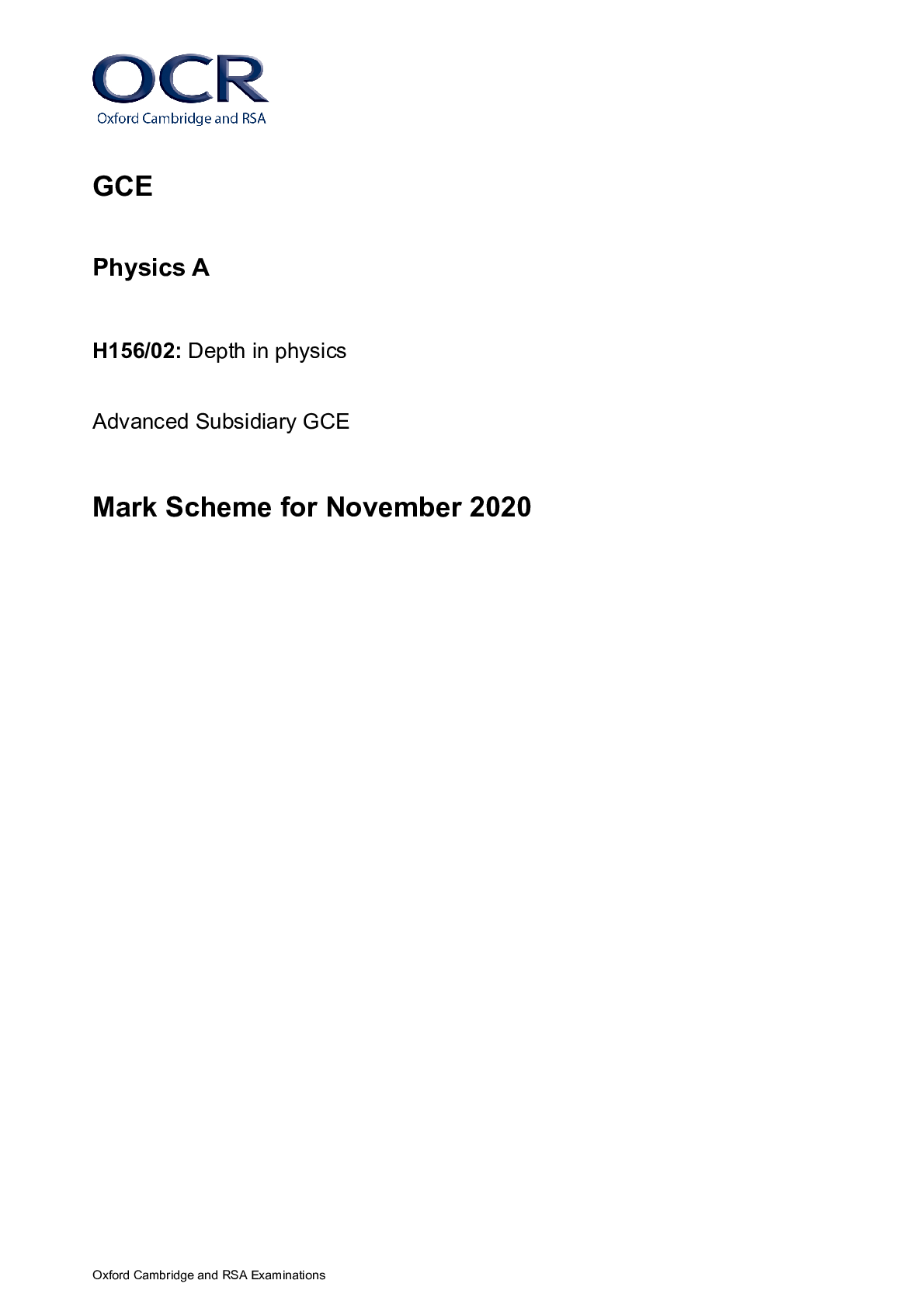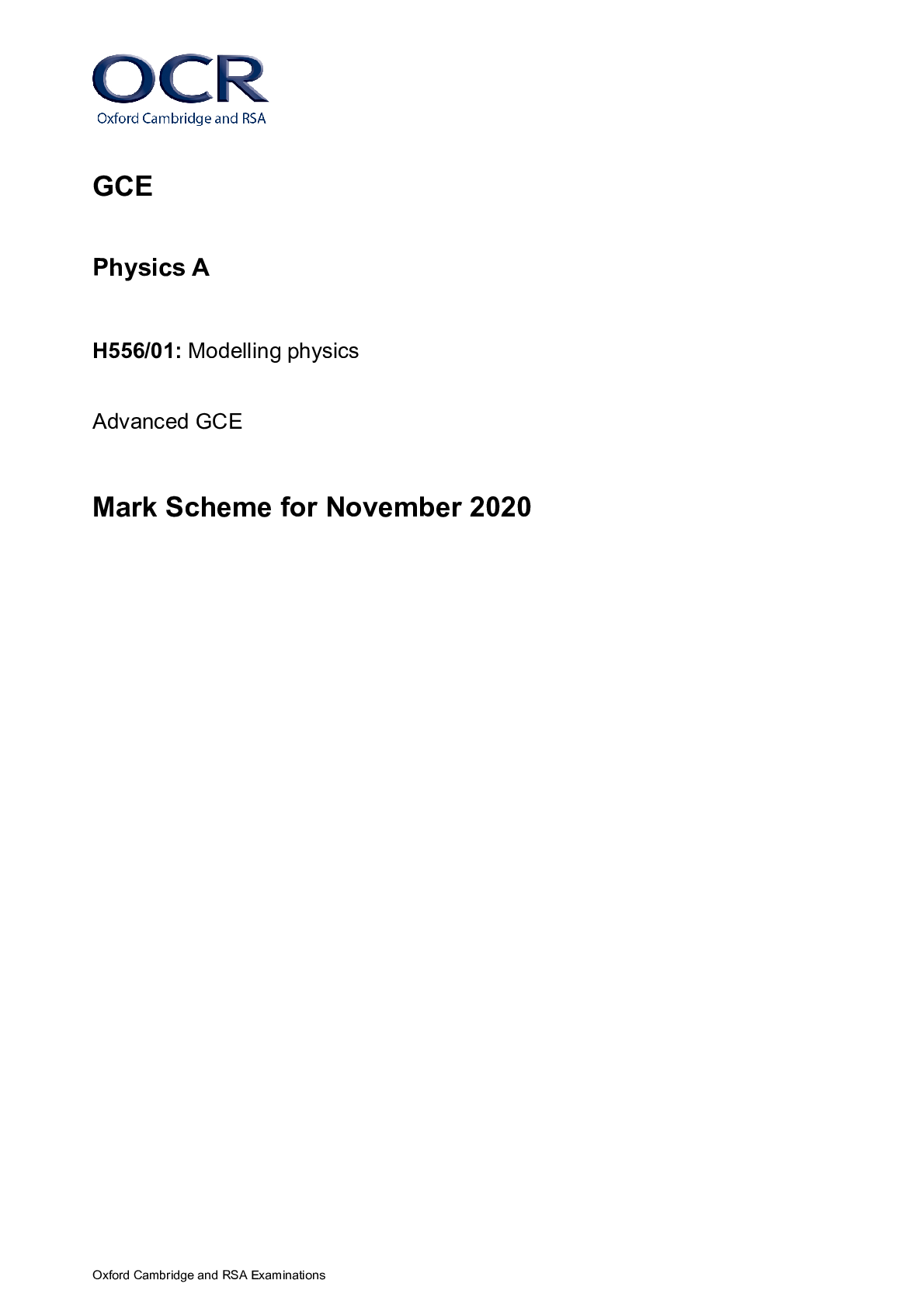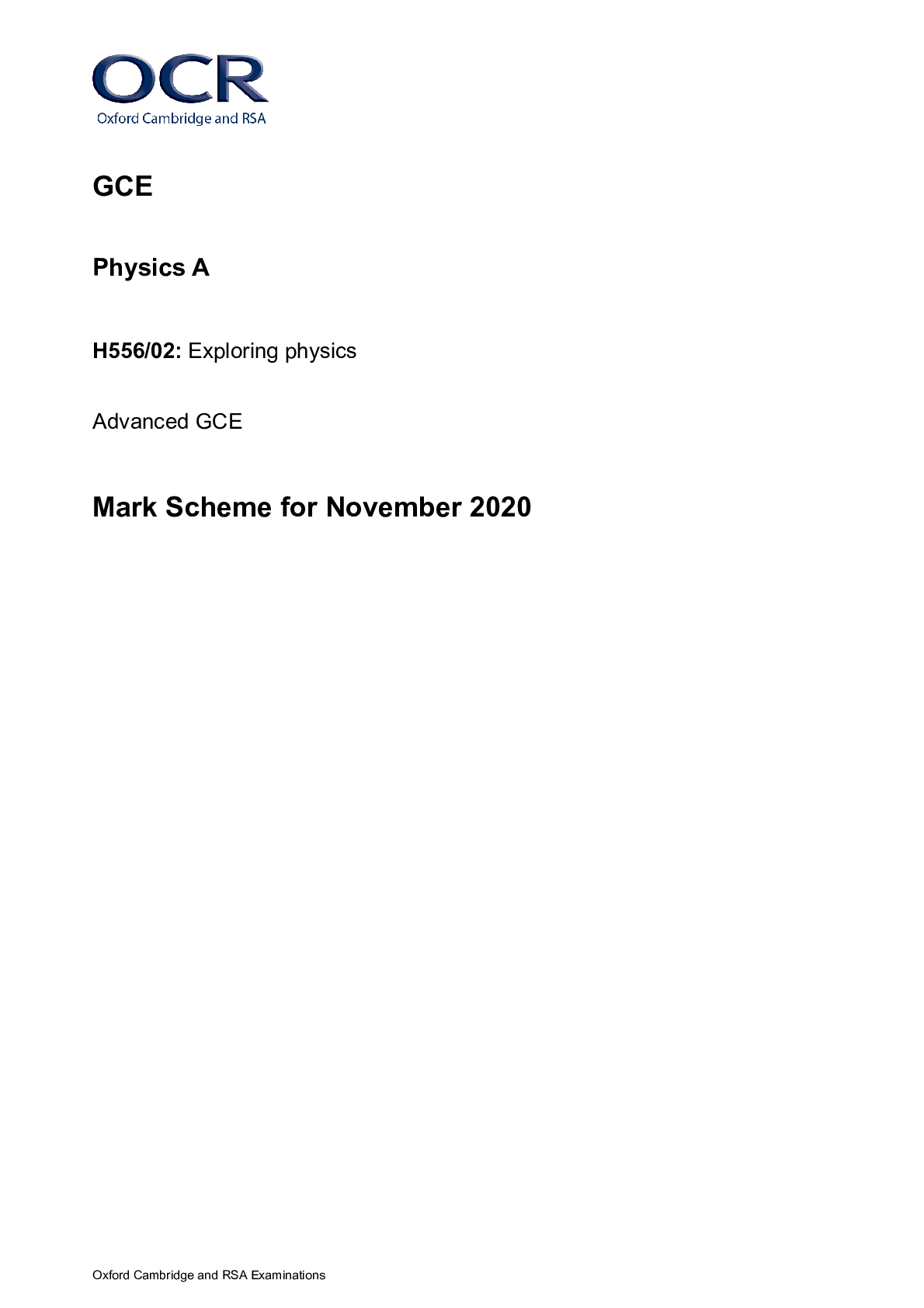Mathematics > AS Mark Scheme > GCE Further Mathematics A Y542/01: Statistics Advanced GCE Mark Scheme for November 2020 (All)
GCE Further Mathematics A Y542/01: Statistics Advanced GCE Mark Scheme for November 2020
Document Content and Description Below
Oxford Cambridge and RSA Examinations GCE Further Mathematics A Y542/01: Statistics Advanced GCE Mark Scheme for November 2020Oxford Cambridge and RSA Examinations OCR (Oxford Cambridge and RSA)... is a leading UK awarding body, providing a wide range of qualifications to meet the needs of candidates of all ages and abilities. OCR qualifications include AS/A Levels, Diplomas, GCSEs, Cambridge Nationals, Cambridge Technicals, Functional Skills, Key Skills, Entry Level qualifications, NVQs and vocational qualifications in areas such as IT, business, languages, teaching/training, administration and secretarial skills. It is also responsible for developing new specifications to meet national requirements and the needs of students and teachers. OCR is a not-for-profit organisation; any surplus made is invested back into the establishment to help towards the development of qualifications and support, which keep pace with the changing needs of today’s society. This mark scheme is published as an aid to teachers and students, to indicate the requirements of the examination. It shows the basis on which marks were awarded by examiners. It does not indicate the details of the discussions which took place at an examiners’ meeting before marking commenced. All examiners are instructed that alternative correct answers and unexpected approaches in candidates’ scripts must be given marks that fairly reflect the relevant knowledge and skills demonstrated. Mark schemes should be read in conjunction with the published question papers and the report on the examination. © OCR 2020Y542/01 Mark Scheme November 2020 2 Text Instructions Annotations and abbreviations Annotation in RM assessor Meaning and BOD Benefit of doubt FT Follow through ISW Ignore subsequent working M0, M1 Method mark awarded 0, 1 A0, A1 Accuracy mark awarded 0, 1 B0, B1 Independent mark awarded 0, 1 SC Special case ^ Omission sign MR Misread BP Blank Page Seen Highlighting Other abbreviations in mark scheme Meaning dep* Mark dependent on a previous mark, indicated by *. The * may be omitted if only one previous M mark cao Correct answer only oe Or equivalent rot Rounded or truncated soi Seen or implied www Without wrong working AG Answer given awrt Anything which rounds to BC By Calculator DR This question included the instruction: In this question you must show detailed reasoning.Y542/01 Mark Scheme November 2020 3 Subject-specific Marking Instructions for A Level Mathematics A a Annotations must be used during your marking. For a response awarded zero (or full) marks a single appropriate annotation (cross, tick, M0 or ^) is sufficient, but not required. For responses that are not awarded either 0 or full marks, you must make it clear how you have arrived at the mark you have awarded and all responses must have enough annotation for a reviewer to decide if the mark awarded is correct without having to mark it independently. It is vital that you annotate standardisation scripts fully to show how the marks have been awarded. Award NR (No Response) - if there is nothing written at all in the answer space and no attempt elsewhere in the script - OR if there is a comment which does not in any way relate to the question (e.g. ‘can’t do’, ‘don’t know’) - OR if there is a mark (e.g. a dash, a question mark, a picture) which isn’t an attempt at the question. Note: Award 0 marks only for an attempt that earns no credit (including copying out the question). If a candidate uses the answer space for one question to answer another, for example using the space for 8(b) to answer 8(a), then give benefit of doubt unless it is ambiguous for which part it is intended. b An element of professional judgement is required in the marking of any written paper. Remember that the mark scheme is designed to assist in marking incorrect solutions. Correct solutions leading to correct answers are awarded full marks but work must not always be judged on the answer alone, and answers that are given in the question, especially, must be validly obtained; key steps in the working must always be looked at and anything unfamiliar must be investigated thoroughly. Correct but unfamiliar or unexpected methods are often signalled by a correct result following an apparently incorrect method. Such work must be carefully assessed. When a candidate adopts a method which does not correspond to the mark scheme, escalate the question to your Team Leader who will decide on a course of action with the Principal Examiner. If you are in any doubt whatsoever you should contact your Team Leader.Y542/01 Mark Scheme November 2020 4 c The following types of marks are available. M A suitable method has been selected and applied in a manner which shows that the method is essentially understood. Method marks are not usually lost for numerical errors, algebraic slips or errors in units. However, it is not usually sufficient for a candidate just to indicate an intention of using some method or just to quote a formula; the formula or idea must be applied to the specific problem in hand, e.g. by substituting the relevant quantities into the formula. In some cases the nature of the errors allowed for the award of an M mark may be specified. A method mark may usually be implied by a correct answer unless the question includes the DR statement, the command words “Determine” or “Show that”, or some other indication that the method must be given explicitly. A Accuracy mark, awarded for a correct answer or intermediate step correctly obtained. Accuracy marks cannot be given unless the associated Method mark is earned (or implied). Therefore M0 A1 cannot ever be awarded. B Mark for a correct result or statement independent of Method marks. Unless otherwise indicated, marks once gained cannot subsequently be lost, e.g. wrong working following a correct form of answer is ignored. Sometimes this is reinforced in the mark scheme by the abbreviation isw. However, this would not apply to a case where a candidate passes through the correct answer as part of a wrong argument. d When a part of a question has two or more ‘method’ steps, the M marks are in principle independent unless the scheme specifically says otherwise; and similarly where there are several B marks allocated. (The notation ‘dep*’ is used to indicate that a particular mark is dependent on an earlier, asterisked, mark in the scheme.) Of course, in practice it may happen that when a candidate has once gone wrong in a part of a question, the work from there on is worthless so that no more marks can sensibly be given. On the other hand, when two or more steps are successfully run together by the candidate, the earlier marks are implied and full credit must be given. e The abbreviation FT implies that the A or B mark indicated is allowed for work correctly following on from previously incorrect results. Otherwise, A and B marks are given for correct work only – differences in notation are of course permitted. A (accuracy) marks are not given for answers obtained from incorrect working. When A or B marks are awarded for work at an intermediate stage of a solution, there may be various alternatives that are equally acceptable. In such cases, what is acceptable will be detailed in the mark scheme. If this is not the case please, escalate the question to your Team Leader who will decide on a course of action with the Principal Examiner. Sometimes the answer to one part of a question is used in a later part of the same question. In this case, A marks will often be ‘follow through’. In such cases you must ensure that you refer back to the answer of the previous part question even if this is not shown within the image zone. You may find it easier to mark follow through questions candidate-by-candidate rather than question-by-question. f We are usually quite flexible about the accuracy to which the final answer is expressed; over-specification is usually only penalised where the scheme explicitly says so. • When a value is given in the paper only accept an answer correct to at least as many significant figures as the given value.Y542/01 Mark Scheme November 2020 5 • When a value is not given in the paper accept any answer that agrees with the correct value to 3 s.f. unless a different level of accuracy has been asked for in the question, or the mark scheme specifies an acceptable range. NB for Specification B (MEI) the rubric is not specific about the level of accuracy required, so this statement reads “2 s.f”. Follow through should be used so that only one mark in any question is lost for each distinct accuracy error. Candidates using a value of 9.80, 9.81 or 10 for g should usually be penalised for any final accuracy marks which do not agree to the value found with 9.8 which is given in the rubric. g Rules for replaced work and multiple attempts: • If one attempt is clearly indicated as the one to mark, or only one is left uncrossed out, then mark that attempt and ignore the others. • If more than one attempt is left not crossed out, then mark the last attempt unless it only repeats part of the first attempt or is substantially less complete. • if a candidate crosses out all of their attempts, the assessor should attempt to mark the crossed out answer(s) as above and award marks appropriately. h For a genuine misreading (of numbers or symbols) which is such that the object and the difficulty of the question remain unaltered, mark according to the scheme but following through from the candidate’s data. A penalty is then applied; 1 mark is generally appropriate, though this may differ for some units. This is achieved by withholding one A or B mark in the question. Marks designated as cao may be awarded as long as there are no other errors. If a candidate corrects the misread in a later part, do not continue to follow through. Note that a miscopy of the candidate’s own working is not a misread but an accuracy error. i If a calculator is used, some answers may be obtained with little or no working visible. Allow full marks for correct answers, provided that there is nothing in the wording of the question specifying that analytical methods are required such as the bold “In this question you must show detailed reasoning”, or the command words “Show” or “Determine”. Where an answer is wrong but there is some evidence of method, allow appropriate method marks. Wrong answers with no supporting method score zero. If in doubt, consult your Team Leader. j If in any case the scheme operates with considerable unfairness consult your Team Leader.Y542/01 Mark Scheme November 2020 6 Question Answer Marks AO Guidance 1 30 53.1 1.96 8 ± M1 A1 A1 3.3 1.1 1.1 Correct structure with 8 Square root correct Awrt 1.96 used, can be implied (49.30, 56.90) A1 [4] 3.4 Both, only these numbers (4 sf needed at least once) Allow e.g. (49.30, 56.9) 2 (a) (i) The points do not lie very close to a straight line B1 [1] 1.1 Or equivalent. Must refer to diagram, not just to “correlation” Ignore extras unless wrong (ii) H0: ρ = 0, H1: ρ > 0, where ρ is the population pmcc between prices in 1972 and prices in 2018 B2 1.1 2.5 One error, e.g. ρ not defined, B1 (but allow “population” not stated) H0: r = 0, H1: r > 0: same scheme, but B2 needs “population” pmcc H0: no correlation, H1: positive correlation: B1 0.381 < 0.4973 M1 1.1 Compare with 0.497(3) Do not reject H0. M1ft 1.1 Correct first conclusion, needs likewith-like FT on CV 0.5760 only There is insufficient evidence of (positive) correlation between prices in the two years. A1ft [5] 2.2b In context, not too definite Exx α: Insufficient evidence to reject H0. No correlation between … M1A1 (bod) β: Wrong first conclusion, correct interpretation: M0A0 γ: Hypotheses wrong way round: maximum M1M1 (b) 0.650 B2 [2] 3.1a 1.1 Full marks for correct answer by any method SC: if B0 allow B1 for any 3 of 8.85, 46.35, 8.8725, 241.7331, 43.153Y542/01 Mark Scheme November 2020 7 Question Answer Marks AO Guidance 3 (a) H0: mA = mB , H1: mA < mB where mA and mB are the median journey times for A and B B1 1.1 OR: Median journey times equal, oe. Allow if ms used but not defined Allow “mean” or “average” only if “population” stated W ~ N(180, 510) B1 1.1 Both, can be implied, needs m = 12 Allow √510 or 5102 Consider correct tail, either 219 or 141 (Rm = 219, m(m + n + 1) – Rm = 141) M1 1.1 Find either P(≤P( 141) (141.5) ≥ 219) (218.5) or Use of 0.9559 is M0 here For CV method see below. p = 141.5 180 510 − Φ = 0.0441… BC M1 A1 1.1 1.1 Needs some evidence. E.g.: 0.0421, 0.0401, 0.470 (no/wrong cc, √): M1 0.0441 < 0.1 A1ft 1.1 Explicit comparison. FT on wrong p-value provided method correct 0.9559 > 0.9: A1A1 (M1A1) 0.9559 > 0.1: A1A0 M0A0 OR: CV 180 – z×√510 141 (141.5) used z = 1.282 (CV = 151.05, 151.058..) 141.5 < 151.05(85) or 218.5 > 208.95 M1 M1 A1 A1 Allow √ errors Stated or implied CV and cc correct e.g. 141 < 150.55 180 + 1.282√510 etc is M0 unless 219 (218.5) used, in which case give M2(A1A1) E.g. 219 > 209.45 Reject H0. Significant evidence that route B takes longer M1ft A1ft [8] 1.1 2.2b Correct first conclusion Contextualised, not too definite Needs like-with-like, e.g. 0.9559 with 0.9 SC Sum of A’s ranks = 435 – 219 = 216 used: B1B0 M0M1A0A1 M1A1 max 5/8 Exx α: H0: Journey times are the same, H1: journey times for B are higher: B0 β: H0: No evidence that median journey times are different, etc: B0 (b) Must be a random sample (of all journeys) Or distributions must be same shape (necessary assumption for Wilcoxon rank-sum test!) B1 [1] 3.5b Or equivalent. Allow “(journeys) independent” Not “representative”.Y542/01 Mark Scheme November 2020 8 Question Answer Marks AO Guidance 4 3E(X) = 30 or E(X) = 10 9×Var(X) = 36 or Var(X) = 4 B1 B1 2.2a 2.2a Used, stated or implied One of these, used, stated or implied 1 2 12 ( 1) 4 n − = M1 1.1 Use variance of uniform ⇒ n = 7 A1 2.2a n = 7 only, no need for “reject –7” E(X – m) = 12 ( 1) n + M1 3.1b Use expectation of uniform, e.g. 2m + n + 1 = 20. Allow if E(3X + m) used rather than E[3(X + m )] OR: Var(Y + m) = 1 2 12 ( 1) n − ⇒ n = 7 E(Y + m) = ½(n + 1) + m M1 A1 M1 1.1 2.2a 3.1b n = 7 only, no need for “reject –7” Use expectation of uniform, e.g. 2m + n + 1 = 20. 10 – m = 4 M1 2.1 Validly derive single equation for m m = 6 A1 [7] 2.2a m = 6 only NB: Var = (n – 1)2/12 is from continuous uniform!Y542/01 Mark Scheme November 2020 9 Question Answer Marks AO Guidance 5 (a) 5 21 5 21 C C C C 3 2 4 1 × + × +1 [= 2100 + 105 + 1] M1dep A1 3.1b 1.1 Any correct pair of nCrs multiplied All terms correct Or 1 – P(0, 1, 2) = 1 – .9665 ÷ 26C5 [= 65780] *depM1 1.1 1103 32890 or 0.0335… A1 [4] 3.2a Awrt 0.0335 or any exact fraction e.g. 2206 65780 or 264720 7893600 OR: Or: 5 3 4 2 1 26 25 24 23 22 × × × × 5 3 4 2 21 26 25 24 23 22 × × × × ×5 5 3 20 4 21 26 25 24 23 22 × × × × ×10 Total 1103 32890 or 0.0335… B1 B1 B1 B1 [4] Must have 5 oe, e.g. 5C1 Must have 10 oe, e.g. 5C3 (b) (i) 22! 5! 26! × 1 2 3 4 5 120 ( ) 23 24 25 26 358800 × × × × = = × × × M1 A1 1.1 2.1 Oe. Allow M1 for 21! instead of 22! Fully correct 1 2 3 4 5 22 23 24 25 26 × × × × × × × × : M1 1 2990 = AG A1 [3] 2.2a Correctly obtain AG using exact method Allow even if no working after 22! × 5! ÷ 26! (ii) 22 fences: 22 for [VVV] × 21 for [VV] M1 3.1b Correct strategy, allow 22C2 for 22P2 21!×3!×2!×22×21: M2A0 Consonants arranged in 21! ways Vowels arranged in 5! ways (= 5P3 × 2P2) M1 A1 1.1 2.1 At least one of these, no subtraction Both correct 21! × 3! × 2! ÷ 26! M0M1 5C3 × 3! × 2! = 5! Product ÷ 26! = 21 2990 (= 2.832×1024 ÷ 4.0329×1026) A1 [4] 3.2a Allow from calculator but must be exact fraction OR: Treat 21 consonants, [VVV] and [VV] as 23 23! × 5! / 26! (= 1/130) Subtract 2 × 1/2990 Answer is 21 2990 M1 A1 M1 A1 [4] 3.1b 2.1 3.2a 1.1 Correct strategy, allow 23!×2!×3! Correct (5! = 5P3×2P2 = 5C3×2!×3!) M1 also for subtracting 1 × 1/2990 Final answer, exact fraction (11/1495 is M1A1M1A0) (Must subtract 2 × 1/2990 as 23! method counts [VVVVV] twice, once as [VVV][VV] and once as [VV][VVV])Y542/01 Mark Scheme November 2020 10 Question Answer Marks AO Guidance 6 (a) Any reason for independence (or not) B1 3.5b “Events occur independently and at constant average rate”: B0 … and for constant average rate (or not), in each case without misunderstanding of what they mean B1 [2] 3.5b SC: Mere assertion of both, properly contextualised: B1 SC: Variance = 4.67 which is closer to 5: B1 SC: Considers only the assumptions given in the question: B0 (b) (i) M1 3.4 Correct method stated or implied 0.146(223) BC A1 [2] 1.1 Correct answer only, awrt 0.146 (ii) 0.133(372) BC M1 A1 [2] 1.1 1.1 0.068: M1A0 (treat 0.1337 as a slip, i.e. give A1 BOD) (c) Po(12.2) M1 3.3 Stated or implied P(≤ 15) – P(≤ 9) [= 0.8296 – 0.2253] M1 1.1 Allow P(≤ 16) or P(≤ 10), e.g. 0.503 or 0.662 (M1M1A0) Allow this M1 also from λ = 7.2 (0.187, 0.110, 0.189) = 0.604(224) BC A1 [3] 3.4 Correct answer only, awrt 0.604 (d) Sales of CD players and integrated systems need to be independent B1 [1] 1.1 Need “independent” or “not related” clearly referred to the two types of machine. Not just “purchases independent” or “distributions independent” (e) If a customer buys a CD player they probably won’t (or will) buy an integrated system as well B1 [1] 3.5b Any reason for non-independence of sales of CD players and integrated sound systems Can get B0B1 provided they are focussing on independence Exx α: May buy both so not independent: B0 β: Often bought together: B1 γ: Misunderstanding of context, e.g. CDs/CD players, or assuming that integrated systems don’t include CD players: can get B1Y542/01 Mark Scheme November 2020 11 Question Answer Marks AO Guidance 7 (a) Geometric M1 1.1 Stated explicitly Mean = 400 ÷ 100 (= 4) and p = 1/mean M1 2.4 Use mean (or P(1) etc) to deduce p (“Determine”, so justification is needed for 0.25) Needs to deduce p in part (a), not defer it to (b) Therefore p = 0.25 A1 [3] 1.1 Allow even if second M1 not gained SC Geo(0.2) using P(1) = 0.2: M1M1A0 (b) Probability is 0.756 (= 0.1779785…) M1 3.3 SC Geo(0.2): 0.86 M1A0 OR: Or: 0.177978 or 0.177979 or better seen, or 1 – [P(1)+ … + P(6)] with evidence, e.g. formula M1 Allow ± 1 term Expected frequency = probability×100 = 17.798 A1 [2] 2.1 17.798 correctly obtained, with sufficient evidence, www 100 – Σ(other frequencies): SC B1 (c) H0: data consistent with (geometric) distribution H1: not consistent B1 1.1 Both, allow equivalents, but not “evidence that …”. E.g. H0: X ~ Geo(p) Allow Geo(0.25) ΣX 2 = 9.005 B1 1.1 9.005 or 9.01 9.005 < 11.07 (ν = 5) B1 1.1 Compare their ΣX 2 with 11.07 Do not reject H0. M1ft 1.1 Correct first conclusion, ft on their 9.005 or on 12.59, needs like-with-like Allow from comparison with 12.59 but nothing else Insufficient evidence that a geometric distribution is not a good fit. A1ft [5] 2.2b Contextualised, not too definite (needs double negative) Don’t penalise “Geo(0.25)” Allow addition slip in ΣX 2 SC Geo(0.2): can get full marks if given data used, ΣX 2 = 4.54 used gets B1B1B0M1A1 Exx α: Reject H0. Data is consistent with geometric: M1A0 β: Insufficient evidence to reject H0. Data is consistent with geometric: M1A1 (BOD)Y542/01 Mark Scheme November 2020 12 Question Answer Marks AO Guidance 8 (a) 1 1 1 d (1 ) n n k kx x n x ∞ ∞ − − = ∫ − M1 B1 1.1 1.1 ICorrect indefinite integral ntegral attempted, correct limits Don’t need full details lim(a → ∞) of = 1 k n − = 1 so k = n – 1 A1 [3] 1.1 Correctly obtain k = n – 1, www (b) (i) 4 3 1 3 d x x c x − ∫ = − + M1 1.1 Needs +between 1 and c or definite integral x, oe Wrong k: can get M1A0B1 x = 1, F(x) = 0 so c = 1. Hence 1 – x–3. A1 1.1 Fully correct active part of CDF Ignore ranges here 3 0 1, F( ) 1 1 1 x x x x < = − ≥ B1 [3] 1.1 “0 for x < 1” stated and no wrong ranges (doesn’t need M1 or A1) Allow ≤ for <, and/or > for ≥ Or “0 otherwise” if “x ≥ 1” stated in active part (ii) P[( 7) ( 5)] P( 7) P( 5) P( 5) X X X X X > ∩ > > = > > M1* A1 3.1a 3.1a Use conditional probability method P[(X > 7) ∩ (X > 5)] = P(X > 7) [1 F(7)][1 F(5)] 1 F(5) − − − : = 1 F(7) 1 F(5) − − *depM1 3.3 Convert probabilities into F(X), not using P(X > 7) × P(X > 5) M1A0M0A0 = 125 343 or 0.364(431…) A1ft [4] 1.1 Any exact fraction or awrt 0.364, ft on 1 – a/x3, a ≠ 0, 1 Allow from F(x) = 1 – a/x3, otherwise www (c) 3 2 2 1 1 E( ) d (3 ) n n kx X kx x n ∞ − ∞ − = = ∫ − (n ≠ 3) M1* B1 2.1 1.1 Correct limits needed somewhere Correct indefinite integral or 1 3 nn − − SC: E( ) , 2 1 3 n X n − = − M1B1 1 E( ) 2 n X n − = − ⇒ n ≠ 2 or 3: (not valid, must consider ln if n = 2 or 3): B0 If n = 3, E(X 2) = lim[2ln( )] x x →∞ , not defined No marks just for this unless last 3 marks all zero, then if this (or for n = 2) is shown, award SC B1 Infinite integral does not converge if 3 – n ≥ 0 *depM1 2.2a Make deduction based on convergence, ft No limits used: M0B1M0B0 If n ≥ 4 then 2 1 E( ) (2 ) kx n X n ∞ − = − converges B1 2.3 Consider convergence of E(X) SC: Var(X) < 0 when n < 3: M1B1M1 (B0) A0 Therefore Var(X) is not defined if and only if n = 2 or 3. A1 [5] 2.2a Shown not defined for n = 2 or 3 and only for those But no need to state “if and only if”OCR (Oxford Cambridge and RSA Examinations) The Triangle Building Shaftesbury Road Cambridge CB2 8EA OCR Customer Contact Centre [Show More]
Last updated: 1 year ago
Preview 1 out of 14 pages
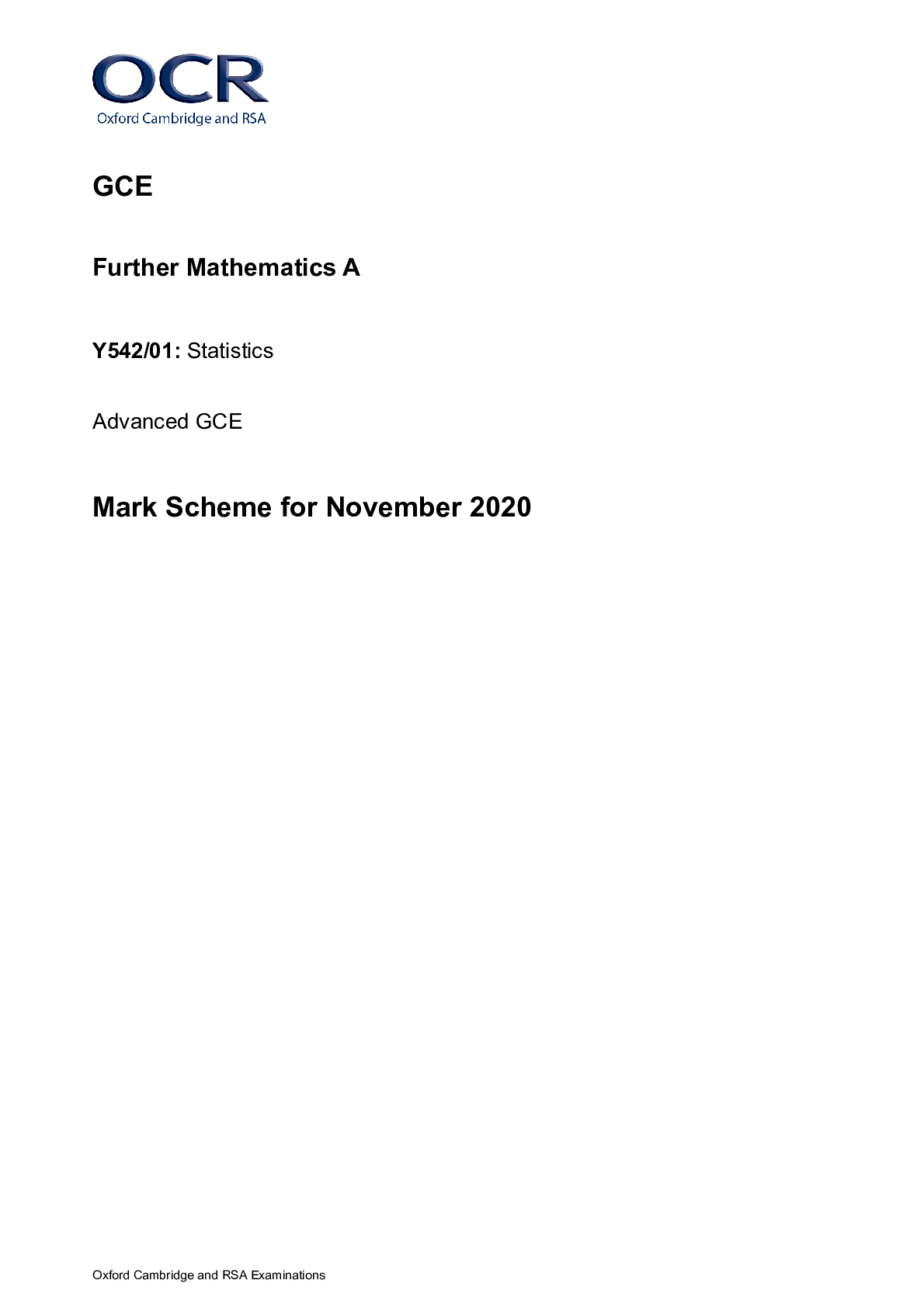
Buy this document to get the full access instantly
Instant Download Access after purchase
Add to cartInstant download
We Accept:

Reviews( 0 )
$6.50
Document information
Connected school, study & course
About the document
Uploaded On
Oct 10, 2022
Number of pages
14
Written in
Additional information
This document has been written for:
Uploaded
Oct 10, 2022
Downloads
0
Views
47

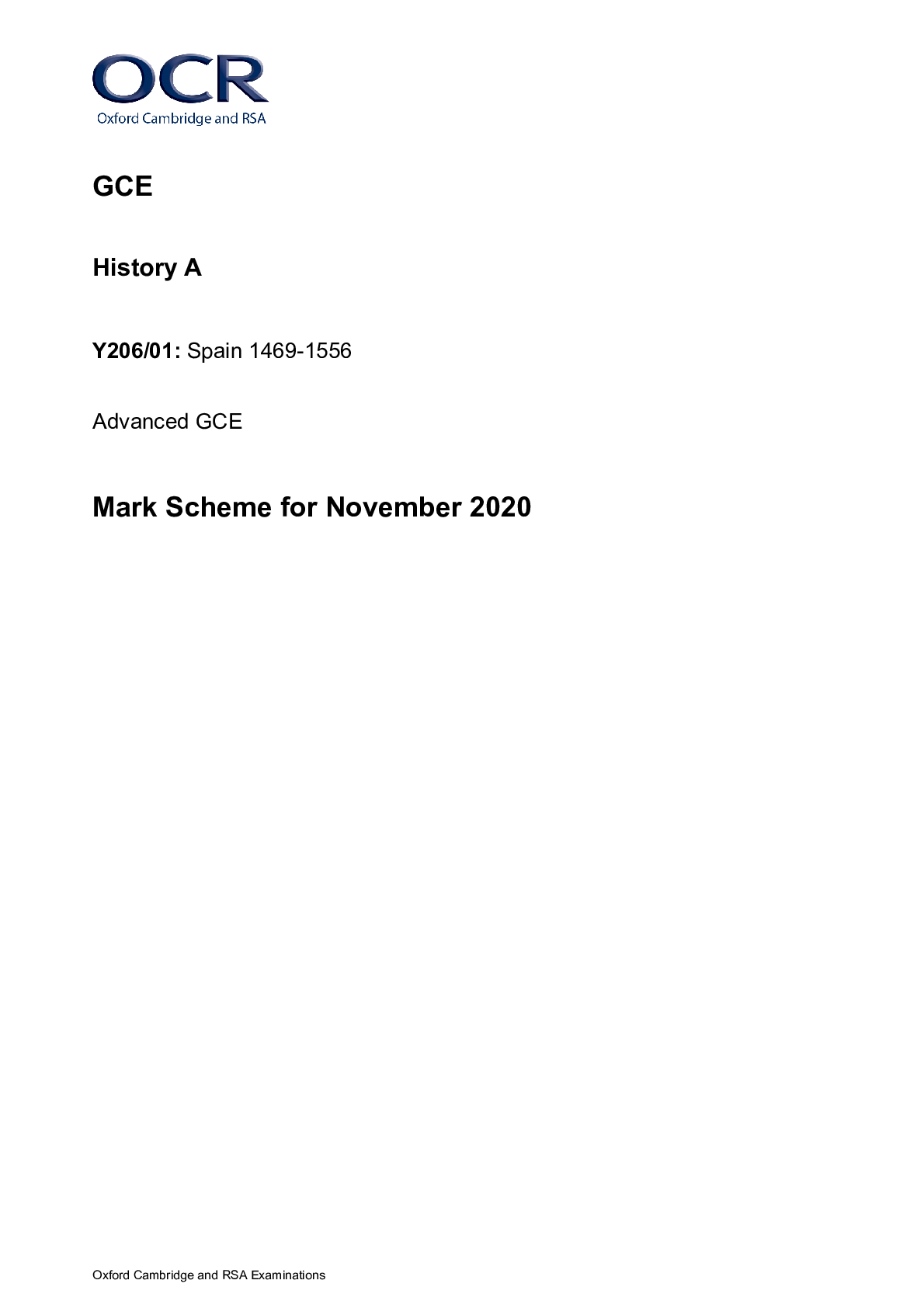
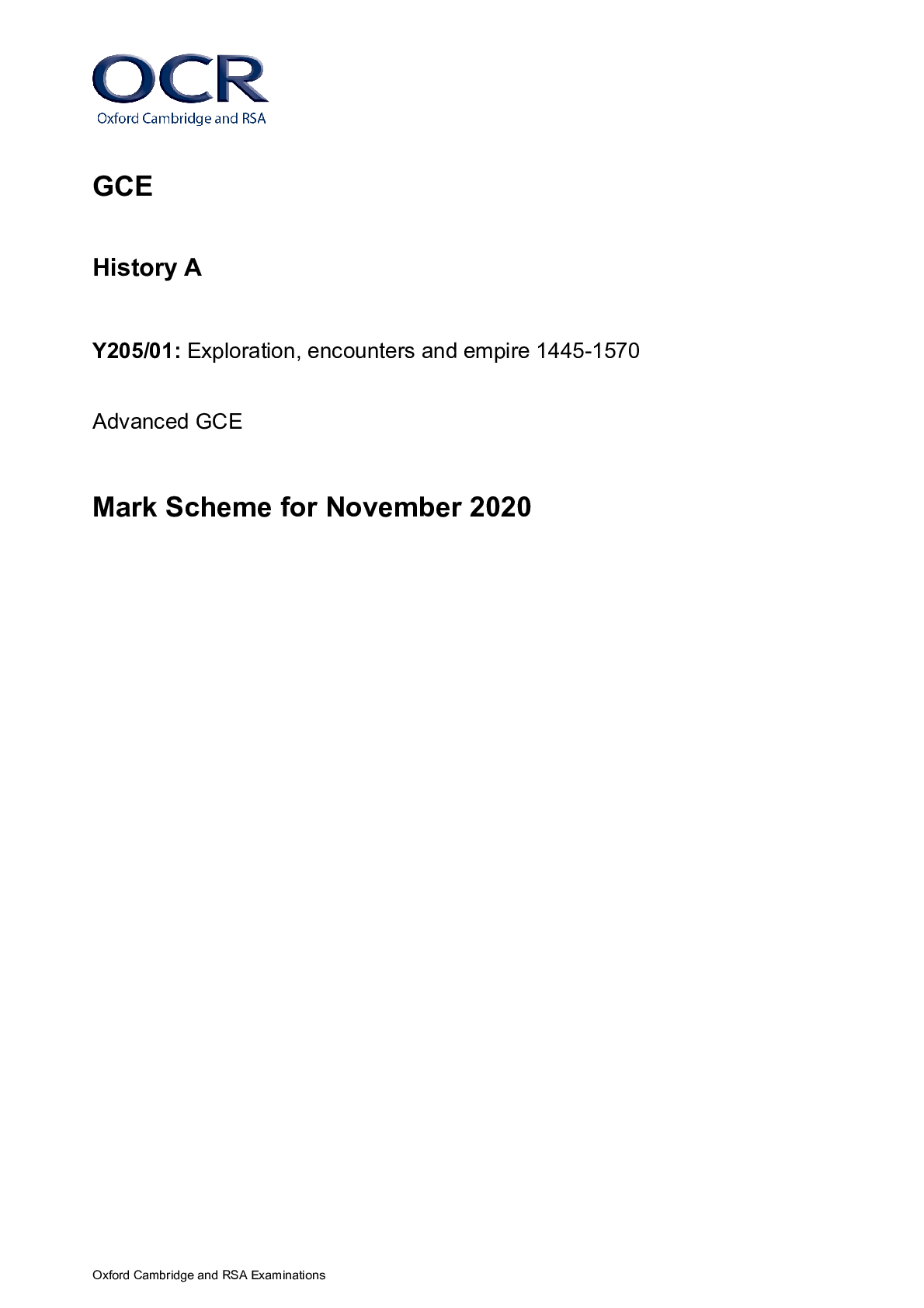






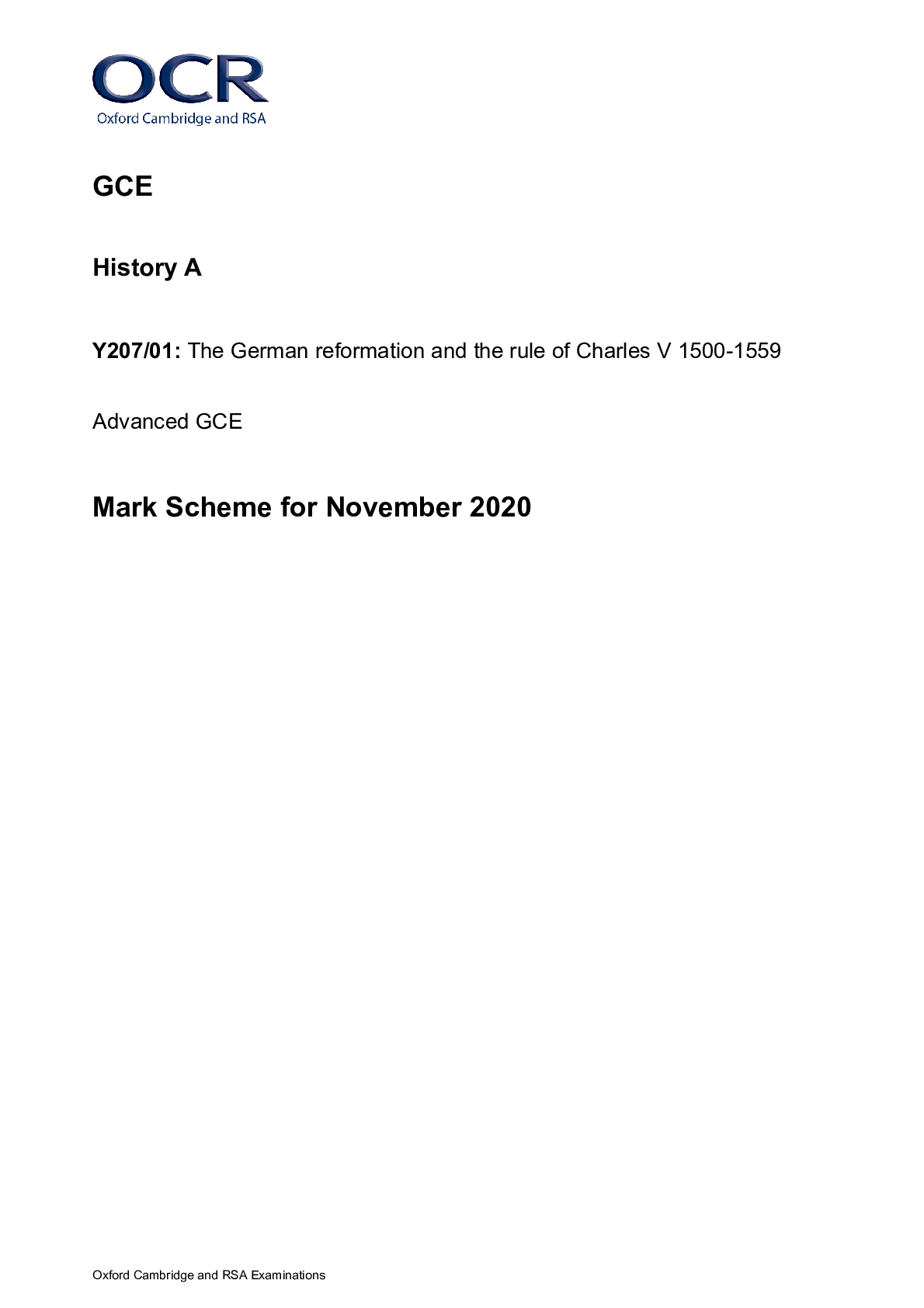






.png)



